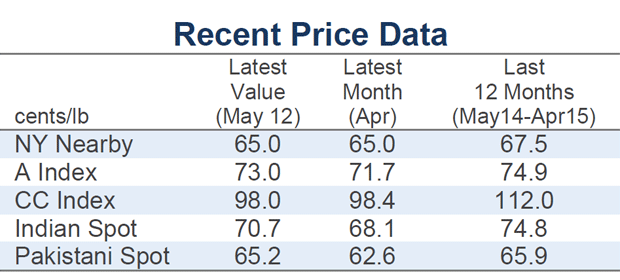
Cotton output to fall, mill-use to rise
The projection for world production in 2015/16 is 111.3 million bales, which represents an 8 million bale decrease (-6.7%) relative to the 119.3 million bales harvested in 2014/15. The forecast for world mill-use in 2015/16 is 115.3 million bales
The projection for world production in 2015/16 is 111.3 million bales, which represents an 8 million bale decrease (-6.7%) relative to the 119.3 million bales harvested in 2014/15. The forecast for world mill-use in 2015/16 is 115.3 million bales, which represents a 3.8 million bale increase (+3.4%) relative to the 111.5 million bales consumed in 2014/15. In their May report, the USDA has released its first complete set of estimates for an upcoming crop year.
In combination, the smaller crop and the increase in use are expected to result in the first production deficit in six crop years. This implies a decrease in ending stocks, and the estimated decline in warehoused supplies is 4 million bales. However, global ending stocks have set a series of successive records over the last four crop years, and there should be little concern of shortage. The 106.3 million bales expected to be sitting in the world’s warehouses at the end of the 2015/16 crop year are more than 70% higher than the average between 2004/05 and 2008/09 (62.1 million bales). Due to what was considered a massive volume of supply during the 2004/05-2008/09 time period, the A Index averaged only 60 cents/lb over those five years.
At the country-level, India is expected to emerge as the world’s largest producer in 2015/16. Previous forecasts for 2014/15 suggested that India would surpass China in the current crop year. However, the slow pace of arrivals led to a series of downward revisions to the Indian harvest figure and pulled recent estimates for Indian production in 2014/15 to a level equal to that for China (30.0 million bales). Reform to government support measures for cotton growers in China is expected to pull Chinese production down by 3.0 million bales in 2015/16. Meanwhile, lower cotton prices are anticipated to result in a decrease of only 500,000 bales in India.
Meanwhile, the Cotton Association of India (CAI) released its April estimate of the cotton crop for the season 2014-15. The CAI has further revised its cotton crop estimate for the season 2014-15 beginning on 1st October 2014 downwards and placed the same at 384.50 lakh bales of 170 kg each.
The projected Balance Sheet drawn by the CAI for the year 2014-15 estimates total cotton supply at 455.40 lakh bales while domestic consumption is estimated at 310 lakh bales thus leaving an available surplus of 145.40 lakh bales. A statement containing the State-wise estimates of the crop and Balance Sheet for the season 2014-15 with the corresponding data for the previous year is enclosed.
Close to 90% of the total crop has already arrived into the market. However, cotton arrivals have fallen drastically during the month of April 2015. Arrivals during April 2015 were 27.05 lakh bales as compared to 40.00 lakh bales that had arrived during the same month last year. This constitutes a fall of about 32%. Compared to last month, ie, March 2015, when 42.20 lakh bales had arrived into the market, cotton arrivals fell by around 36% to 27.05 lakh bales during the month of April 2015.
Outside of China and India, notable year-over-year decreases are expected in virtually every major cotton producing country, including the U.S. (-1.8 million bales, from 16.3 million to 14.5 million), Pakistan (-600,000 bales, from 10.6 million to 10.0 million), Turkey (-400,000 bales, from 3.2 million to 2.8 million), the African Franc Zone (-330,000, from 4.6 million to 4.2 million), Mexico (-316,000 bales, from 1.4 million to 1.0 million), and Brazil (-250,000 bales, from 7.0 million to 6.8 million).
While lower cotton prices can discourage planting, they can also encourage consumption. In terms of mill-use, the largest year-overyear increases are expected to occur in India and China. Indian milluse is projected to rise 1.3 million bales (from 24.5 million to 25.8 million). Chinese mill-use is projected to increase 1.0 million bales (from 35.0 million to 36




